Hailing from the freshwater rivers and streams of Central Africa, the African dwarf frog is a small but lively amphibian that has become a popular pet in recent years.
These charming little frogs are lively, cute, and relatively straightforward to care for, making them a good choice for beginners who want to keep something a bit different as pets.
Betta fish only require a small tank and are absolutely gorgeous to look at, making them a favorite with many aquarists.
But could you enjoy the best of both worlds? Can African Dwarf frogs live with bettas?
Generally, the two species won’t bother each other unless you have an especially aggressive betta fish. The frogs are nocturnal creatures, whereas bettas are diurnal, being most active during the day, so the two won’t come into conflict, provided the frogs have plenty of places to hide and sleep.
Read this guide to learn what steps you need to take to ensure harmony in a betta and African Dwarf frog combo tank.
The African Dwarf Frog’s Personality
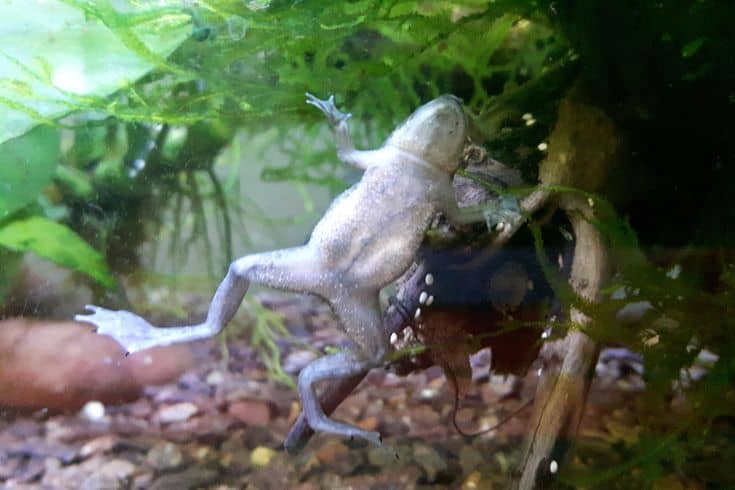
The African dwarf frog is a social creature that does best when kept in pairs or small groups. They are generally peaceful and do not bother other tankmates, but they may nip at the fins of fish much larger than them. This makes them rather bold for such a small animal, but their playfulness makes them quick to forgive and forget.
African dwarf frogs are also quite active and playful, staying busy throughout the day. They are known to chase each other and play tag, which is a little ironic considering that these critters have such poor eyesight! Be that as it may, their speedy little movements and lively antics make them fun to watch.
The Bettas’ Personality
Bettas, on the other hand, are not known for their friendliness. They are a species that is quite aggressive and territorial. Male bettas are especially prone to this behavior and will often fight with other males (and even their reflection!) if they feel threatened. Be that as it may, they can still be relatively peaceful when kept with suitable tank mates.
Female bettas are not as aggressive as males but can still be territorial. They are also known to be nippy, so they should not be kept with smaller fish that could fit into their mouths. Otherwise, they are generally peaceful and make excellent tank mates for most animals.
I once kept a betta sorority in a community tank without problems. I had five female bettas in the group, one of which became the dominant fish and sometimes asserted her authority over the others. However, aside from a few minor squabbles, the sorority was peaceful and got along well with the other tank residents.
So, Can African Dwarf Frogs And Bettas Live Together?
Strange as it may seem, yes! Despite their different personalities, the two are fundamentally social animals that enjoy companionship. More importantly, they can both hold their own against the other, so they are unlikely to become bullies or be bullied.
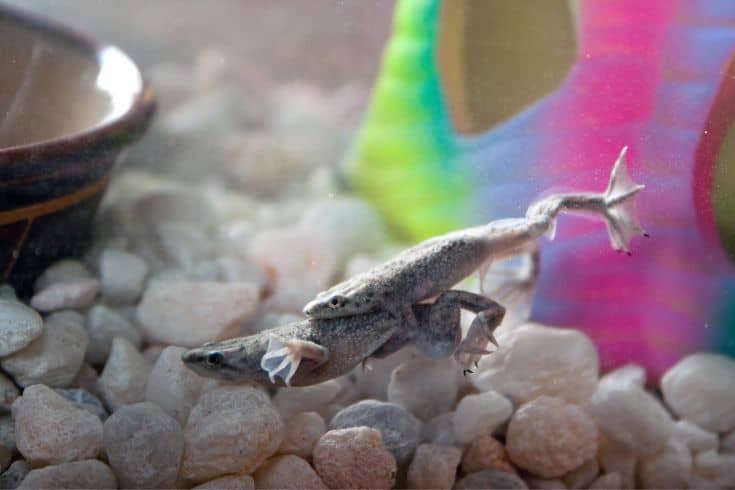
To give you a better picture of how this may play out, let’s address the fact that an aggressive betta may choose to chase and attack an African dwarf frog. In this scenario, the frog may hide or try to escape. However, because African dwarf frogs are faster swimmers than bettas, the frog will likely be able to outmaneuver the fish and escape to safety.
On the other hand, if an African dwarf frog gave in to its playful nature and decided to nip at a betta’s fins, it would be quickly met with an aggressive response. Bettas have sharp teeth that they use to tear at the fins of their enemies, and while the frog would not be hurt too badly, it would quickly learn to stay away from the betta’s fins.
So, while there may be some chasing and nipping at first, these two species can generally coexist without real problems. Over time, they will learn to ignore each other and go about their business. Of course, there are always exceptions to the rule, but this is generally how it works out.
Housing African Dwarf Frogs and Bettas Together
If you decide to house African dwarf frogs and bettas together, you can do a few things to maximize your chances of success. You want to ensure that each animal has enough space to move around and that there are plenty of places to hide if they feel threatened.
Provide Adequate Space
We’ve mentioned that bettas and African dwarf frogs have a feisty streak, so providing them with enough space to move around is crucial. Typically, people allocate one gallon of tank space for every inch of fish they have. However, the rules are a little different when you’re trying to accommodate two different species with different space requirements.
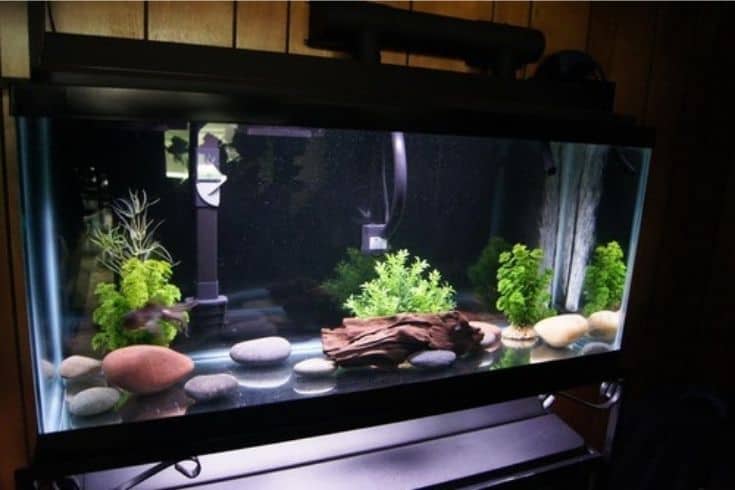
A 10-gallon tank works for a solo species tank, but 20 gallons is the minimum tank size if you want to form a community tank with one betta and up to two African dwarf frogs. You’ll need an even larger tank if you want to house multiple males or betta sorority with your frogs – at this point, we’re looking at something closer to a 40-gallon aquarium.
Generally, we recommend going with the largest tank size you can accommodate because it will give the animals more room to move around and establish their respective territories. You should also consider using a shorter aquarium, because both species need to make frequent trips to the surface to gulp some air. A taller tank would make this more difficult for them.
At the end of the day, it’s really up to you to decide what size tank to get. Remember that more space is always better when housing multiple animals together. You can always start with a smaller tank and upgrade to a larger one if needed.
Create Hiding Places
The next thing you’ll want to do is create hiding places for both your bettas and your African dwarf frogs. Many people opt for tank dividers as part of their aquarium setup, but we personally think it’s not the best approach. After all, part of the fun of having a community tank is creating a cohesive and visually appealing aquarium ecosystem, not dividing it into tiny compartments!
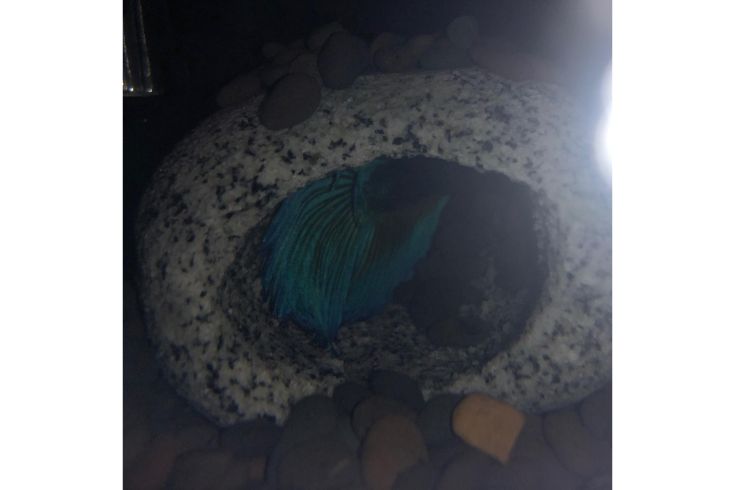
Instead, we recommend creating different “zones” and hiding spots for both species. Most gravel for betta tanks works well for this purpose, as do rocks and driftwood. After gathering your supplies, grab a pair of aquarium forceps and decorate away! We like drawing inspiration from river basins and rice paddies – these habitats will make your pets feel right at home.
Another thing to note is that creating areas with shallow water and areas with deep water will also help your animals feel more comfortable. Both bettas and African dwarf frogs like to rise to the surface to breathe, and having different depths to choose from will allow them to do so without feeling exposed.
Some hobbyists also enjoy using artificial decor such as pipes and caves, but we recommend sticking to natural materials if possible. In our experience, both bettas and African dwarf frogs seem to prefer it. However, plastic decor can work in a pinch – just make sure it doesn’t have any sharp edges that could injure your pets.
Maintain Ideal Water Parameters
Last but not least, it’s important to maintain ideal water parameters in your tank. Both bettas and African dwarf frogs are sensitive to changes in water conditions, so it’s essential to keep a close eye on things like pH, temperature, and ammonia levels.
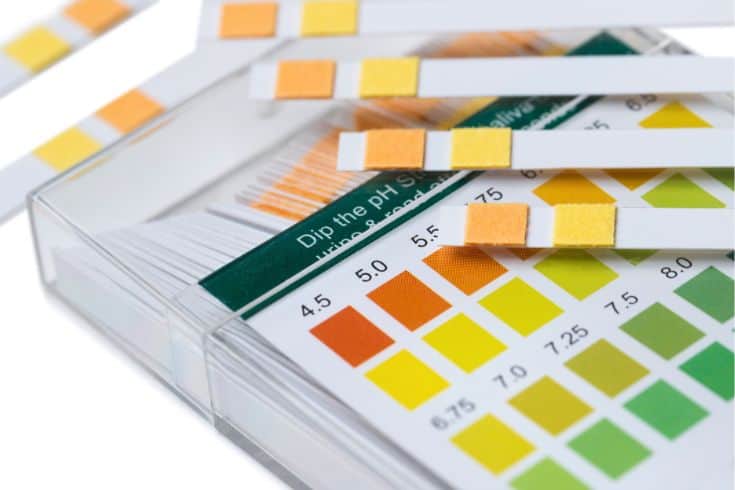
To give your pets the best possible chance at a long and healthy life, we recommend using reverse osmosis water to start with, before slowly remineralizing and adjusting the pH to match their needs. This will guarantee that your water has the exact parameters you need – nothing more, nothing less.
We also recommend testing your water at least once weekly to ensure everything is in order. If you notice any changes, take action immediately to correct the problem. For example, these creatures enjoy warmer water. So, if you notice that the temperature in your tank has dropped, consider investing in an aquarium heater to maintain a consistent environment.
These are just some of the many things you can do to create a safe and comfortable home for both bettas and African dwarf frogs. But that’s only part of the equation – the other part is feeding them the right food, in the quantities and manner. We’ll cover that next.
Dietary Similarities Between African Dwarf Frogs and Bettas
One of the reasons why African dwarf frogs and bettas make such good tank mates is because they are carnivores with similar dietary needs. In the wild, both species are opportunistic feeders, which means they’ll eat just about anything they can get their hands (or mouths?) on. This includes insects, larvae, small crustaceans, and other invertebrates.
In practice, this means that you can use similar food sources for bettas and African dwarf frogs. They will both thrive on a varied diet made up of different protein sources, the most common of which include brine shrimp, blood worms, or any type of pre-prepared foods formulated for their respective species.
Some hobbyists find it difficult to feed their pets live protein sources because they are worried about contaminating the water quality in their tank. If this is a concern for you, we recommend using freeze-dried or frozen food from a reliable source. At the end of the day, as long as your pets are being fed high-quality food, they will be just fine.
Though African dwarf frogs and bettas enjoy similar diets, many seasoned fishkeepers recommend feeding them separately. Let’s take a look at why this is the case.
Feeding African Dwarf Frogs and Bettas Separately
One of the most important things to do when housing African dwarf frogs and bettas is to ensure they’re both getting enough to eat. Fishkeepers often find bettas are more aggressive eaters and will quickly gobble up all the food before their froggy buddies have a chance to get anything.
To avoid this problem, we recommend feeding them separately. That way, you can be sure that both pets get the nourishment they need, without having to worry about one hogging all the grub. There are a few different ways to accomplish this. First, you could use a tank divider and feed your frogs on one side while your bettas eat on the other. This is a straightforward solution, and one that is very effective.
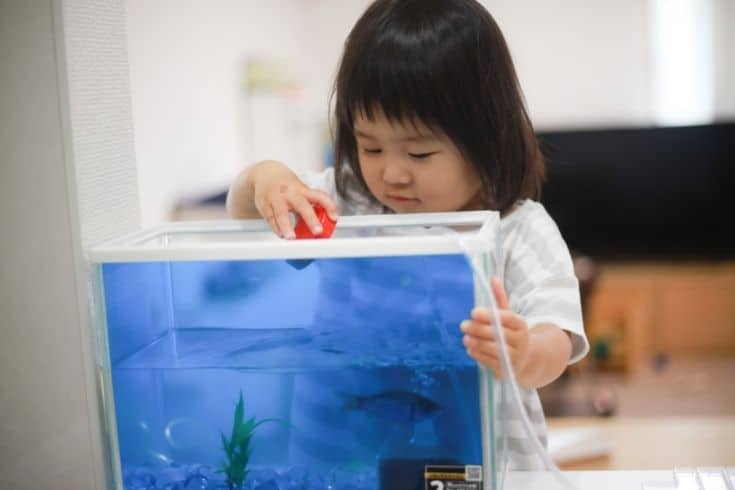
Another option is to use a specially formulated frog food that sinks to the bottom of the tank. These usually come in pellet form, and contain all the nutrients and vitamins your frogs need to stay healthy. Most importantly, bettas are unlikely to eat pellets that sink, so this method ensures that your frogs get their fair share.
On the off-chance that your frog is actually the more aggressive feeder among the two, you could apply the same philosophy and include betta food that floats. Frogs do not feed from the surface of the water as often as bettas do, so this should guarantee that your betta gets its meals. Of course, this method is less reliable than the others, but it’s still worth considering.
General Feeding Reminders
In all the excitement of setting up a new tank and adding new pets, it’s easy to forget some of the basics when it comes to feeding them. Here are a few things to keep in mind:
- Always remove any uneaten food from the tank after each feeding. Excess food not only pollutes the water, but it can also lead to health problems for your pets.
- Be mindful of your pet’s feeding schedule. Overfeeding can lead to bloating, swim bladder disease, and other health problems, so it’s important to stick to a regular feeding schedule.
- Always source your food from a reliable source. This is especially important if you’re feeding live food to your pets. Make sure the food is free of disease and parasites, and that it’s properly quarantined before being added to the tank.
As long as you keep these things in mind, you should have no problem keeping your African dwarf frogs and bettas healthy and well-fed.
The Takeaway
There you have it – everything you need to know about keeping African dwarf frogs and bettas together in the same tank! This combination may be an odd one, but it’s definitely a fun and interesting one. Just remember to do your research, and to take things slowly at first. With a little time and patience, you’re sure to have a thriving and unique aquarium in no time.
Did you find this article helpful? If you did, please share it with fellow fish enthusiasts! And, as always, feel free to contact us if you have any questions or concerns. We’re always happy to help! Thanks for reading, and happy fishkeeping!
